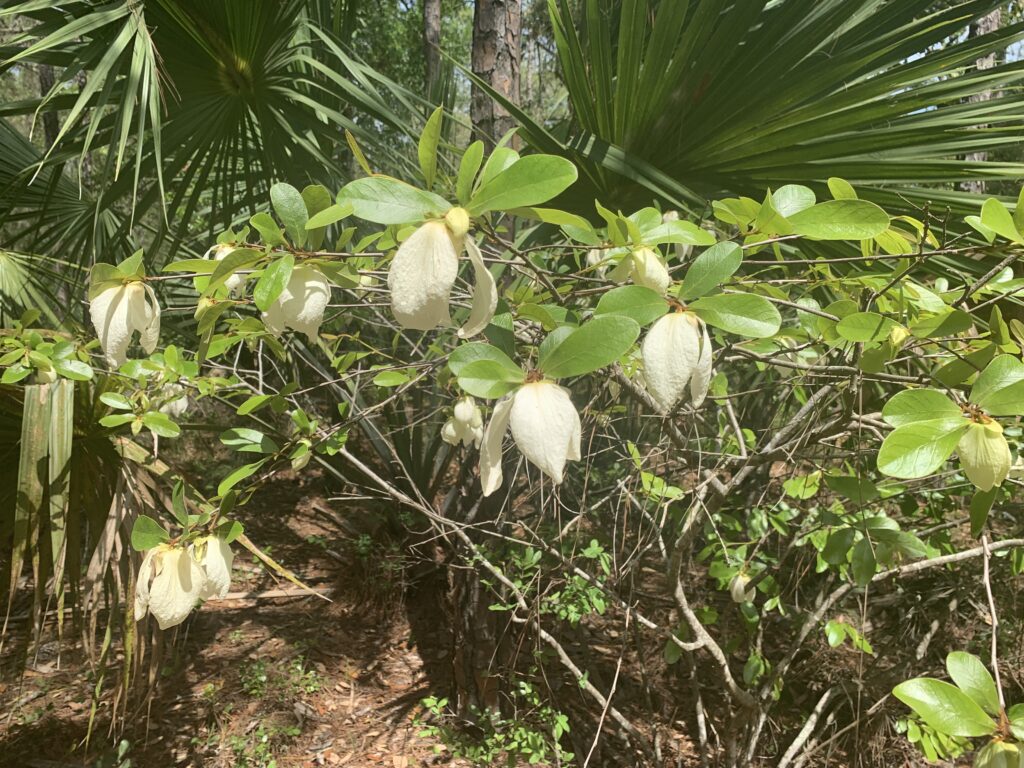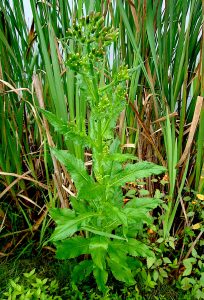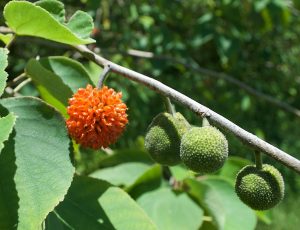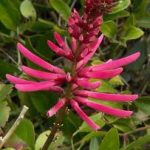
Pawpaws are in heavy bloom now. Photo by Green Deane
NOW is the time to identify pawpaw shrubs so you can harvest the fruit later on. We saw many pawpaws along the entrance to Princess Place in Palm Coast where one of our foraging classes was held last week. An attractive mis-size shrub locally its white blossom are a key identifying element this time of year. They are also easy to spy in pastures next to roadways. Historically paw paw was a favored fruit of George Washington. To read more about pawpaw go here.

Burnweed/Fireweed in blossom in front of cattails. Photo by Green Deane
We also saw hundreds of fireweed, Erechtites hieraciifolius, a food and medicine. While the plant is around all year it is in its prime now. The plant is edible raw or cooked, depending on what your palate prefers. Fireweed also has a history as a poultuce of easing issues related to hemmorrhoids. The common names. fireweed and burnweed, is a cause for confusion. The common burnweed and fireweed on the East side of the United States is Erechtites hieraciifolius.

Fireweed grows from sea level to the sub-alpine zone.
There is another fireweed/burnweed on the west side of the United States, the red blossomed Epilobium angustifolium, also edible — leaves, blossoms and peeled roots. Older leave are used for a tea. It is not in the Daisy family like the east coast plant. This fireweed is actually found in most countries that encircle the north pole. In Canada it is called Great Willowherb. It is also a host plant for several moths including the fireweed clearwing (Albuna pyramidalis), bedstraw hawkmoth (Hyles gallii), and the nessus sphinx moth (Amphion floridensis).Bear and Elk like to eat it.
On the east coast of my native state of Maine about seven miles south of Portland is the Town of Scarbrough. There you will find Pine Point and Black Point, two capes separated by the Nonesuch River which empties into Casco Bay. These points are less than a thousand feet apart as the seagull flies. Pines predominant on southern Pine Point and the darker-colored spruce on northern Black Point. Why? Soil? Human intervention? No. Ocean currents meet at those points making Black Point slightly cooler annually — attractive to spruces — and Pine Point slightly warmer which is more attractive to pines.

Paper Mulberries are related to bread fruit. Photo by Green Deane
Distance and or elevation can significantly affect plant selection and growth. Here in flat-iron Florida a 60-mile separation decides whether our Paper Mulberries pictured left, will have fruit or not. In the northern areas of the state the tree is putting on fruit. In the central part of the state it rarely fruits because the winters are usually too warm. The Paper Mulberry is from a temperate climate and prefers cooler temperatures. The tree sprouts orange pom-pom like fruit. The orange part is edible but not the seed in the middle. If you want to read more about the Paper Mulberry you can go here.

Foraging classes are held rain or shine, heat or cold. Photo by Nermina Krenata
Foraging classes: April is an interesting foraging month. It’s month in which many local species fruit, such as mulberries, blueberries, and blackberries.
April 8th, Saturday, Mead Garden: 1500 S. Denning Dr., Winter Park, FL 32789. 9 a.m. to noon
April 15th Saturday, Bayshore Live Oak Park, Bayshore Drive. Port Charlotte, meet in the parking lot at Bayshore and Ganyard. 9 a.m. to noon
APril 16th Sunday, Lori Wilson Park, 1500 N Atlantic Ave, Cocoa Beach, FL 32931, meet at the bathrooms, north side, 9 a.m. to noon.
April 22nd, Saturday, George LeStrange Preserve, 4911 Ralls Road, Fort Pierce, FL, 34981, 9 a.m. to noon.
For more information. to sign up for a class or to pre-pay go here.

Humming birds like the Eastern Coral Bean
Also blossoming this time of year is the Eastern Coral Bean, sometimes called the Cherokee Bean. What is odd about this plant is the edible flowers produce toxic beans. So we do not eat the red and black beans. A few of the red blossoms are edible raw — with precautions — but they are usually boiled then mixed with other foods notably scrambled eggs. When you cook the blossoms they turn light green. The distinctive shape of the leaves makes the shrub easy to identify. Young leaves are edible cooked but are marginal fare. Like Pawpaws they prefer dry, sunny places. A few raw red blossoms seem okay but if eaten in larger amounts they can be mind altering and approaching dangerous. Boiled they are fine. (Juice from the shrub’s stems, by the way, has been used to treat scorpion stings and the toxic beans have a chemical that is close to the alkaloid curare which can cause breathing paralysis.) You can see my video about the species here or read more about the Eastern Coral Bean here.

You get the USB, not the key.
My nine-DVD set of 135 videos has been phased out and replaced by 171-videos on a 128-GB USB, see right. The USB videos are the same videos I have on You Tube. Some people like to have their own copy especially if social order falters. The USB videos have to be copied to your computer to play. If you want to order the USB go to the DVD/USB order button on the top right of this page or click here. That will take you to an order form. Or you can make a $99 donation, which tells me it is for the USB (include a snail-mail address.) I’d like to thank all of you who ordered the DVD set over the years which required me to burn over 5,000 DVDs individually. I had to stop making them as few programs now will read the ISO files to copy them. Burning a set also took about three hours.

Green Deane Forum
Want to identify a plant? Perhaps you’re looking for a foraging reference? You might have a UFO, an Unidentified Flowering Object, you want identified. On the Green Deane Forum we — including Green Deane and others from around the world — chat about foraging all year. And it’s not just about warm-weather plants or just North American flora. Many nations share common weeds so there’s a lot to talk about. There’s also more than weeds. The reference section has information for foraging around the world. There are also articles on food preservation, and forgotten skills from making bows to fermenting food. Recent topics include: Stale Bread and Cod Liver Oil, Killing Bugs with Tobacco Plugs, Eating weeds: Is it safe? Have they mutated? Not the Eastern Red Bug but the Pink Tabebuia, African Tulip Tree, Asparagus densiflorus, Green Deane’s Book… You can join the forum by clicking on the button on the upper right hand side of this page.
This is my weekly newsletter #552. If you want to subscribe to this free newsletter you can find the sign-up form in the menu at the top of the page. My website, EatTheWeeds.com, which is data secure, has over 1500 plants on it in some 428 articles. I wrote every one myself, no cut and paste.
To donate to the Green Deane Newsletter click here.

